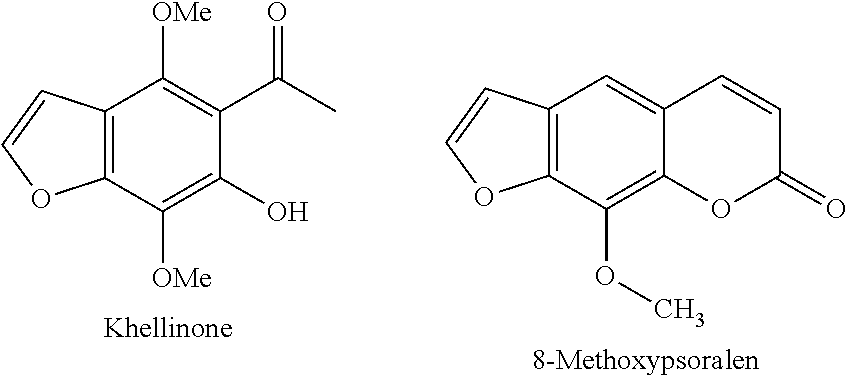Potassium channel blockers and uses thereof
a potassium channel blocker and potassium channel blocker technology, applied in the field of compounds, can solve the problems of increased medical care costs and income loss, inflammation and scarring, damage to blood vessels,
- Summary
- Abstract
- Description
- Claims
- Application Information
AI Technical Summary
Problems solved by technology
Method used
Image
Examples
example 1i
[0163]
1a) 3-Acetyl-2,6-dimethoxy-4-methylphenylacetate
[0164]A stirred solution of 3,5-dimethoxy-4-hydroxytoluene (10.63 g, 0.063 mol) in acetyl chloride (26.6 mL, 0.373 mol) was heated at 40° C. for 0.5 h. LCMS showed complete conversion to the acetate intermediate. The reaction mixture was cooled to 0° C. and DCM (100 mL) was added. TiCl4 (7.6 mL, 0.069 mol) was added dropwise and the reaction mixture warmed to room temperature. After 1.5 h, LCMS showed complete conversion to the bisacetylated product. The reaction was quenched by pouring onto ice / H2O (500 mL) and the product extracted with DCM (200 mL). The organic phase was washed with H2O (2×100 mL), dried over MgSO4 and concentrated in vacuo. The product was recrystallised from 3:1 hexane / EtOAc yielding the title compound (11.1 g, 69%) as a red / brown crystalline solid. 1H NMR (300 MHz, CDCl3) δ 6.53 (s, 1H), 3.80 (s, 3H), 3.76 (s, 3H), 2.47 (s, 3H), 2.32 (s, 3H), 2.24 (s, 3H), MS (ES+) m / z [M+H]+ 253.2.
[0165]
1b) 1-(3-Hydroxy-2,...
example 2e
[0181]
2a) 1-{3-[3-(4-Fluorophenyl)butoxy]-2,4-dimethoxy-6-methyl-5-nitro-phenyl}-ethanone
[0182]Example 1b) (3.05 g, 12.0 mmol) and 1-(3-bromo-1-methyl-propyl)-4-fluorobenzene (3.07 g, 13.3 mmol) were reacted as described under General Procedure D. The crude product was purified by flash chromatography (silica gel, hexane / diethyl ether, 1:4) to give the title compound (4.05 g, 84%) as a pale oil. 1H NMR (300 MHz, CDCl3) δ 7.19-7.14 (m, 2H), 7.00-6.95 (m, 2H), 3.98-3.83 (m, 8H), 3.03-2.95 (m, 1H), 2.46 (s, 3H), 2.09 (s, 3H), 2.08-2.01 (m, 2H), 1.28 (d, J=6.9 Hz, 3H). ESIMS m / z [M+H]+ 406.2.
[0183]
2b) 1-{3-[3-(4-Fluorophenyl)butoxy]-4-hydroxy-2-methoxy-6-methyl-5-amino-phenyl}-ethanone
[0184]Example 2a) (0.42 g, 1.03 mmol) was treated with LiCl as described for Example 1d) and the resulting o-nitrophenol was treated with hydrogen in the presence of Pd / C as described for Example 1e). The crude product was not purified further. 1H NMR (300 MHz, CDCl3) δ 7.21-7.15 (m, 2H), 7.03-6.96 (m, 2H)...
example 3
[0191]
5-Acetyl-7-[3-(4-fluorophenyl)butoxy]-4-methyl-6-(2-pyridin-2-yl-ethoxy)benzooxazole
[0192]Example 2d) (111 mg, 0.31 mmol) was reacted with 2-(2-mesylethyl)pyridine as described under General Procedure D to give the title compound (51 mg, 36%) as an orange / brown oil. 1H NMR (CDCl3) δ 8.54 (dddd, J=5.1, 2.7, 1.8, 0.9 Hz, 1H), 7.95 (s, 1H), 7.61 (dt, J=7.8, 2.1 Hz, 1H), 7.25 (m, 1H), 7.17-7.12 (m, 3H), 6.99-6.93 (m, 2H), 4.34 (t, J=6.6 Hz, 2H), 4.27-4.10 (m, 2H), 3.18 (t, J=6.6 Hz, 2H), 3.05-2.98 (m, 1H), 2.39 (s, 3H), 2.34 (s, 3H), 2.08-1.93 (m, 2H), 1.29 (d, J=6.9 Hz, 3H), MS (ES+) m / z 463.3 (M+H+).
PUM
| Property | Measurement | Unit |
|---|---|---|
| particle size | aaaaa | aaaaa |
| temperature | aaaaa | aaaaa |
| temperature | aaaaa | aaaaa |
Abstract
Description
Claims
Application Information
 Login to View More
Login to View More - R&D
- Intellectual Property
- Life Sciences
- Materials
- Tech Scout
- Unparalleled Data Quality
- Higher Quality Content
- 60% Fewer Hallucinations
Browse by: Latest US Patents, China's latest patents, Technical Efficacy Thesaurus, Application Domain, Technology Topic, Popular Technical Reports.
© 2025 PatSnap. All rights reserved.Legal|Privacy policy|Modern Slavery Act Transparency Statement|Sitemap|About US| Contact US: help@patsnap.com



